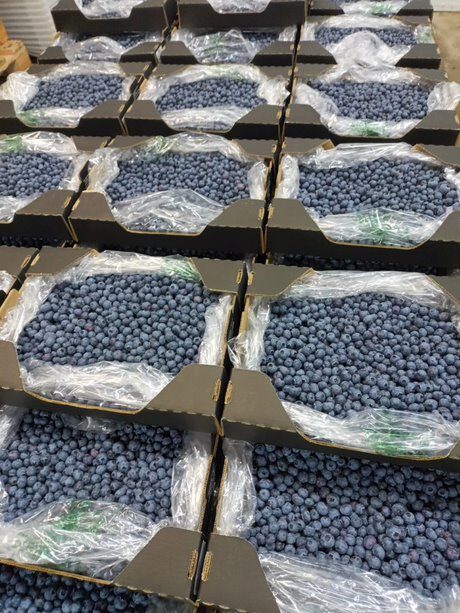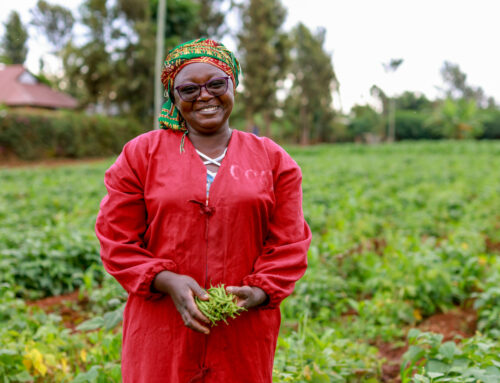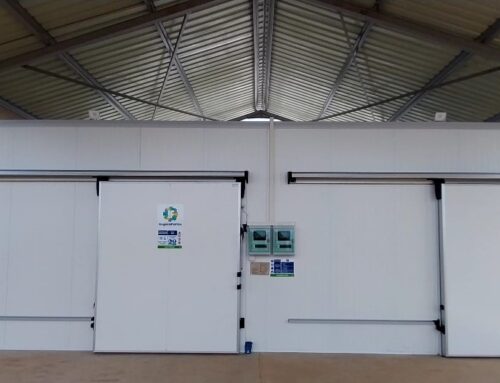Zimbabwe’s blueberry exporter benefits from efficient on-farm cold room for export-grade berries
The Zimbabwean horticultural sector is growing rapidly in response to the increasing demand for fresh fruit and vegetables in the European Union (EU), UK, Middle East, far East and regional markets. Zimbabwe’s horticulture industry has a competitive advantage with its excellent climate conditions and off-season production of high-value crops in high demand such as blueberries, mangeout peas, French beans and more. To meet export standards, Zimbabwean growers and exporters are heavily investing in on-farm and near farm cooling infrastructure to meet food safety standards, meet quality requirements and reduce losses and claims.
This is the case of Wiserow Enterprises, a horticulture producer and exporter located at the Green Pastures Estate, Ruzawi Road, Marondera in Zimbabwe on a 43-ha farm; with 173,000 blueberry plants and 30 ha of peas development. It was established in 2017 to specialise in the growing blueberry demand across Africa, the United Arab Emirates, and Europe. The facility’s site is where the berries are grown, packed, refrigerated, and dispatched for direct export to their current export markets in South Africa, Dubai, Europe and the United Kingdom. Altogether, with 15 ha of blueberries under tunnels and plastics and 28 ha in the open fields, they hold 10 varieties of blueberries on-farm.
Besides blueberries, they also grow peas for the same markets, and in 2021, they exported 330 tonnes of blueberries and 250 tonnes of peas. In 2022, their goal is to produce 450 tonnes of blueberries for their current markets in Singapore, Hong Kong, Holland, the UK and Europe. In the most recent season, they upgraded their cold chain infrastructure with cold rooms to ensure they delivered their produce in fresh conditions that meet their global certification standards.
According to Bruce Meikle, the General Manager at Wiserow, 30 % of their produce goes through air freight, and 70% goes through sea freight. With the high and rising costs of airfreight, Wiserow has had to send more of their products by sea freight to get a viable return. By sea-freight, their fruits spend almost 25 days in a reefer container, and for this reason, good quality precooling and cold chain is critical for them to achieve the desired fruit quality all through to their destination on shelves.
“With the impact of COVID-19 and other disruptions on fresh produce logistics, the cost of our airfreight provider has almost doubled within three years, and we have shifted more of our produce to sea-freight. This means that our cooling practices have had to be top-notch to deliver high-quality produce even after sea-freight.”
High-quality cooling for export-grade blueberries
In 2021, InspiraFarms supported Wiserow with their expansion plan, which included replacing their old cooling system. The company had a 900sqm packhouse to be upgraded for expansion, and this upgrade and integration consisted of:
- The addition of a new receiving cold room of 104m2, that included 56m2 of receiving cold room and two pre-coolers with a dimension of 48m2.
- Cooling of packhouse floor, through an air conditioning unit to keep packhouse at target temperature of 10 – 15 degree celsius.
- An additional final product holding cold room of 66m2 with two forced air blast chillers to drop temperature for final dispatch and ensure target shipping temperatures are achieved.
- Humidifiers for each cold room.
- Complete remote monitoring system, that includes a set of key sensors and weather station.
Postharvest cooling and handling of blueberries
“Before we adopted the InspiraFarms cold room, we had a receiving cold room, which could run at 8 to 10 degrees. Without any blast chilling facilities, it would be hard for us to bring down our temperatures consistently to below 10 degrees. However, our system now has inbuilt blast chillers, and we can achieve this easily.”
Their challenge with this old system was its ability to accurately attain cooling temperatures lower than 8 degrees Celsius in due time. For this reason, they would often dispatch fruits with pulp temperatures of 6 to 8 degrees, which is unideal for long transit periods like theirs, as their fruits would often soften in transit.
Additionally, Bruce shares that this is worse in the hotter months, as it would take 48 hours for the pulp temperatures to get to temperatures between 8 and 10. Today, with an InspiraFarms cooling system, it takes them between 30 minutes to an hour, depending on the volumes and heat periods at the harvest periods.
“We strive to always get our fruits to the cold room one hour after picking them. We then put them into the pre-coolers to remove the field heat within an hour of coming from the field in preparation for sorting. At this point, the temperature is brought down to about 10 to 12 degrees Celsius within an hour and held at 10 degrees until we package it. To optimise the efficiency of our cooling, we normally pack within 24 hours of this arriving from the field and ensure that the temperatures in our processing floor remain between 10 to 15 degrees Celsius.”
Once the fruit is packaged, they pass it through forced air cooling of between 0-2 degrees Celsius and are maintained at this temperature well after. After packaging, Bruce explains that they place their crates in the final stage of cooling, where they maintain at around 2 degrees, ready for transport in temperature-controlled trucks within two to three days.
Common challenges during cooling of fresh berries for export.
Condensation is likely to occur in between pallets, punnets and trays in cases of poor ventilation and ineffective cooling technology. According to Bruce, condensation had been a recurring challenge before. When this happens on fruit surfaces and along their packaging, it provides favourable conditions for microbial growth and fruit softening, lowering the product quality. To work around this, Bruce demonstrates that they adopt a step-down approach to cooling and precooling. With precooling, they bring down the field heat to 10-12 degrees Celsius, and not the sudden 0-2 degrees Celsius, so they avoid condensation issues from the sudden drop of humid temperature. Additionally, Bruce shares that, with the inbuilt forced air coolers on their InspiraFarms cold room, they have excellent ventilation across all pallets, they efficiently control any probable condensation issues long before they happen.
“To ensure we are efficiently cooling down to the core of our fruit, we use a probe to measure the core temperature of the produce to 10 degrees. From the holding cold room, we move it to the processing unit of the air-conditioned packaging unit to be packaged.”
What is the ROI of precooling and an efficient cold chain?
With Wiserow’s previous cooling technology, Bruce shares that they did have quite a few claims from produce loss, and they had to pay the additional cost of destroying the produce.
“In the last year that we used our previous cooling solution, we received 15 claims in one year. Last year, we received only two claims, and we attribute this massive improvement in the efficiency of our cooling and data monitoring system. We have recorded a vast improvement from where we were, with our cooling. For instance, in comparison, we have had about 120,000 USD savings on claims alone. This only goes to show that our upgrade in high-value cooling assets paid for itself within one year!”
When asked about the decision to adopt InspiraFarms as their choice of provider of cooling solutions, Bruce had this to say:
“The other cold room options we looked at in the market at the time were cheaper, but we did not see their understanding of the specific cooling needs we had for our produce type and market. What we gained from InspiraFarms was technical expertise in product design and technical know-how of every single one of our produce needs from the point of harvest to deployment for transit.”
According to Bruce, their past cooling conditions were monitored by their team manually, but now they use a set of digitised data monitors, InspiraConnect. This is a set of hardware consisting of IoT-enabled sensors, data loggers, and electronics, to optimise their post-harvest cooling. With 24/7 access to such vital data, Bruce shared that they now make informed decisions based on scientific data and not just feelings.
“We can also look back at the live history of our cooling data in any case of shipment complaints and monitor our energy usage to help us improve our energy efficiency. This access to reliable energy data is really important for our ongoing plans of moving part of our packhouse to an off-grid powering solution, so having access to real-time monitored data is critical for us.”
Regarding their experience with the InspiraFarms aftersales services, Bruce shares that the InspiraFarms data platform has proved to be very beneficial, as the remote monitoring system allows engineers from InspiraFams to provide remote monitoring and troubleshooting, before having to send a technician on-site every time they need something troubleshot.



